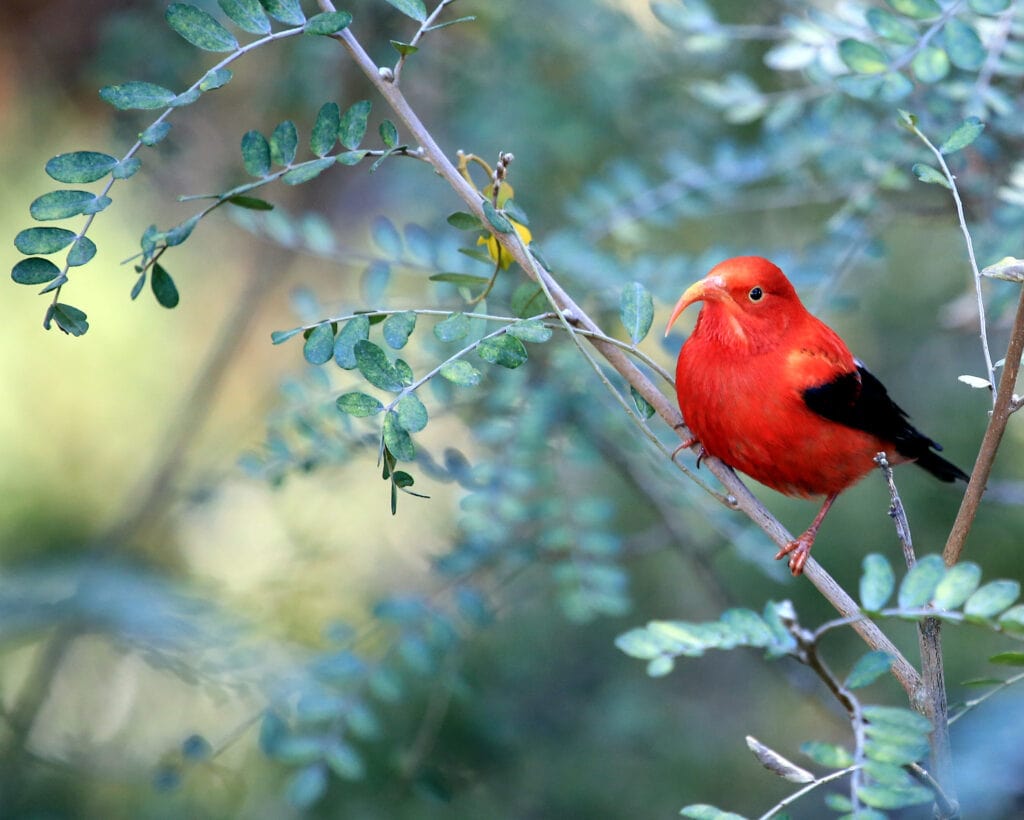There are two sets of birds which fall under the “Honeycreeper” name. The “true” Honeycreepers are a group of small, brightly colored songbirds which are closely related to Tanagers and are found throughout the tropical regions of the Americas, from Mexico down to South America. The second group is the Hawaiian Honeycreepers. This diverse and fascinating group of songbirds is full of unique adaptations. Hawaiian Honeycreepers are endemic to Hawaii and their isolated island habitat has led them to evolve some very interesting strategies for rainforest survival.
Honeycreepers of both groups are generally specialized for feeding on nectar. Like Hummingbirds, Honeycreepers often sport long decurved bills, perfect for piercing the bases of flowers or dipping into flowers to retrieve the nectar which they eat. Hawaiian Honeycreepers, however, have a more broad range of specializations. Some, like the striking red ‘Apapane use their bills for sipping nectar. Others, like the oddly parrot-like Kiwikiu, also fittingly known as the “Maui Parrot-bill,” use their bills for foraging for insects. Many Hawaiian Honeycreepers are more Nuthatch-like in their habits than they are Hummingbird-like. (1)(2)
Honeycreepers of both groups are gorgeous, vibrant songbirds which represent the richness of the tropics and the incredible density of beautiful wildlife which dwells in the rainforests of the Americas. In this article, we’ll look at some of the cultural associations connected with Honeycreepers as well as the traits and lessons that these birds can share with us. If you’ve been wondering about the meaning of the Honeycreeper then wonder no more! Read on to learn all about this brightly-colored jewel of the tropics!
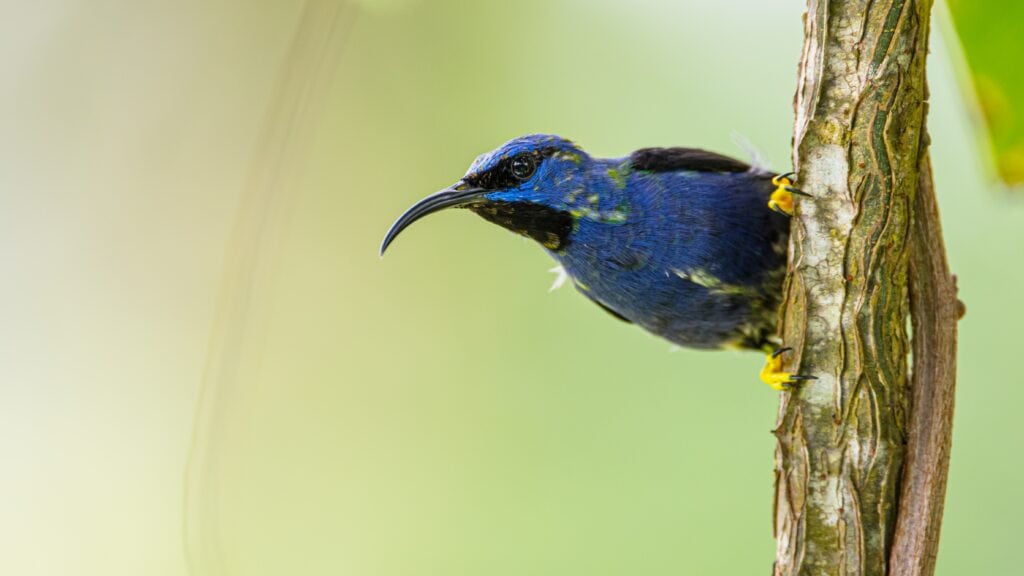
Honeycreeper Symbolism and Meaning
Hawaiian Honeycreepers have the dubious distinction of representing the plight of critically endangered birds in Hawaii and throughout the world. At one time, Hawaiian Honeycreepers were a diverse group with more than fifty individual species. Today, only seventeen of these species are known to persist. Several of those remaining are critically endangered with numbers as low as to fall in the double digits. This rapid decline has been relatively recent and has been largely due to the introduction of non-native threats such as diseases and predators. Habitat loss has also been a major stressor. (3)
There are fewer than 2,000 ‘Ākohekohe, or “Crested Honeycreepers,” remaining. Like many of Hawaii’s Honeycreepers. ‘Akohekohe is under threat from both non-native predators, like cats, and from mosquitos. In Hawaii, non-native mosquitos have wrought devastation upon native birds thanks to the avian malaria and avian pox that they often carry. In the case of Kiwikiu, the Maui Parrot-bill, this issue has reduced numbers to as few as 200 individuals. Because of this, Honeycreepers may represent the precarious position that endangered birds find themselves in. They also represent the importance of conservation and the necessity of preserving and maintaining the remaining wild rainforest habitats within Hawaii. (4)(5)
Honeycreepers may also represent evolution, specialization, talent, or adaptability. As discussed above, Honeycreepers have distinctive and unusual bills which are often designed to take advantage of nectar-rich flowers. Some Hawaiian Honeycreepers are unique in that they have specialized in other areas and have developed different bill shapes to reflect their specializations. In a way, Hawaiian Honeycreepers resemble Darwin’s famous finches which allowed the pioneer of the theory of evolution to observe the different ways that birds evolve to better fill their ecological niches. (6)
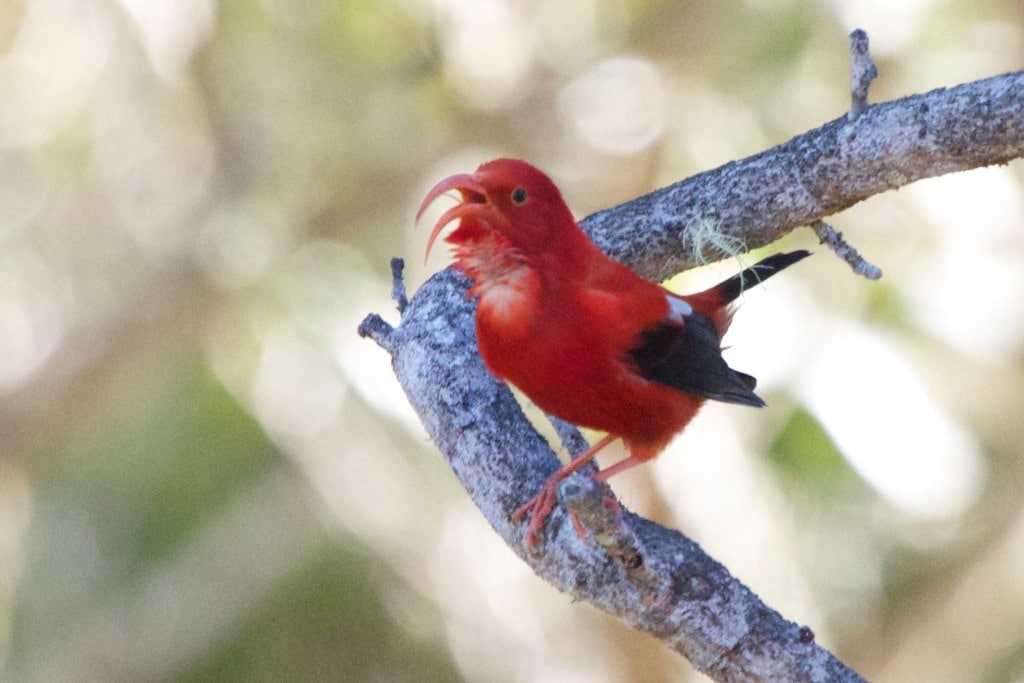
The ‘I’iwi is one of several Honeycreepers who engage in an interesting behavior known as “altitudinal migration.” Altitudinal migrants migrate over short distances to differing elevations. ‘I’iwi does this to follow the flowers as they bloom at different elevations throughout the year. For this reason, Honeycreepers may be connected with travel or nomads, with flowers and gardening, and with opportunity. (7)
Many Native Hawaiians connect Honeycreepers with Hawaii itself. Many see the Honeycreeper as symbolic of the spiritual connection between the Hawaiian people and the lush landscape of the Hawaiian islands.
One Honeycreeper, ʻAkiapolaʻau, is known for a particularly unique nesting strategy. ʻAkiapolaʻau builds fences around its nest using strips of bark from the ‘Ohi’a tree. The protruding strips of bark are said to resemble a picket fence and are thought to provide the nest with an extra bit of camouflage. This is especially necessary because ‘Akiapola’au only lays a single egg each nesting season. These birds spend as long as five months raising their young. Their nests are a major investment in their future and require quite a lot of devotion. So, the Honeycreeper may represent parenthood, the home, safety, protection, or patience. (8)
Honeycreeper Hawaiian Symbolism
Some Honeycreepers, like ‘I’iwi, are considered especially culturally important to Native Hawaiian peoples thanks to their resplendent coloration. ‘I’iwi’s plumage was so treasured that it was often used in ceremonial garb for spiritual purposes, for displaying one’s status, and even for war. Traditionally, the feathers of ‘I’iwi and other rainforest birds were procured by “Kia Manu” or “bird catchers.” these bird-catchers would use sticky latex to capture birds and remove a few feathers before rereleasing them. This is no longer practiced because of the protected status of native Honeycreepers, but these ceremonially important feathers are mimicked using the dyed feathers of common domestic birds as an alternative. (9)
Honeycreeper in Dreams
Dreaming of a Honeycreeper may refer to one’s natural talents or abilities. A Honeycreeper dream is a great reminder to take advantage of your talents and find unique ways to shine. Instead of trying to fit into a mold, find ways to build your life around the unique and special traits that allow you to stand out amongst the crowd.
Dreaming of a true Honeycreeper of the Tanager variety may refer to misconceptions or wrongly held beliefs. Thanks to an old myth, it has long been believed that some of these tropical birds lay black eggs. This has been found to be false, but the myth persists. Dreaming of a nest with black eggs may refer to lies or deception. (10)
Honeycreeper Encounters and Omens
In Hawaii, many Honeycreeper species are so rare that encountering one is a matter of both incredible patience and no small measure of luck. A Honeycreeper encounter may, then, be a special reminder to live in the moment and cherish the opportunity to enjoy one of nature’s rarest beauties. It may also act as a reminder that it is the responsibility of mankind to protect these endangered birds as well as endangered wildlife around the world.
Honeycreeper in Mythology & Folklore
In the following section, we’ll look at a pair of Hawaiian myths which feature Honeycreepers. The ‘I’iwi and ‘Apapane are specifically highlighted in these two stories. I’ve also included a recent chant which was written to celebrate the Hawaiian name of the Kiwikiu. The Kiwikiu’s Hawaiian name was chosen in 2010 because its original Native Hawaiian name had been lost.
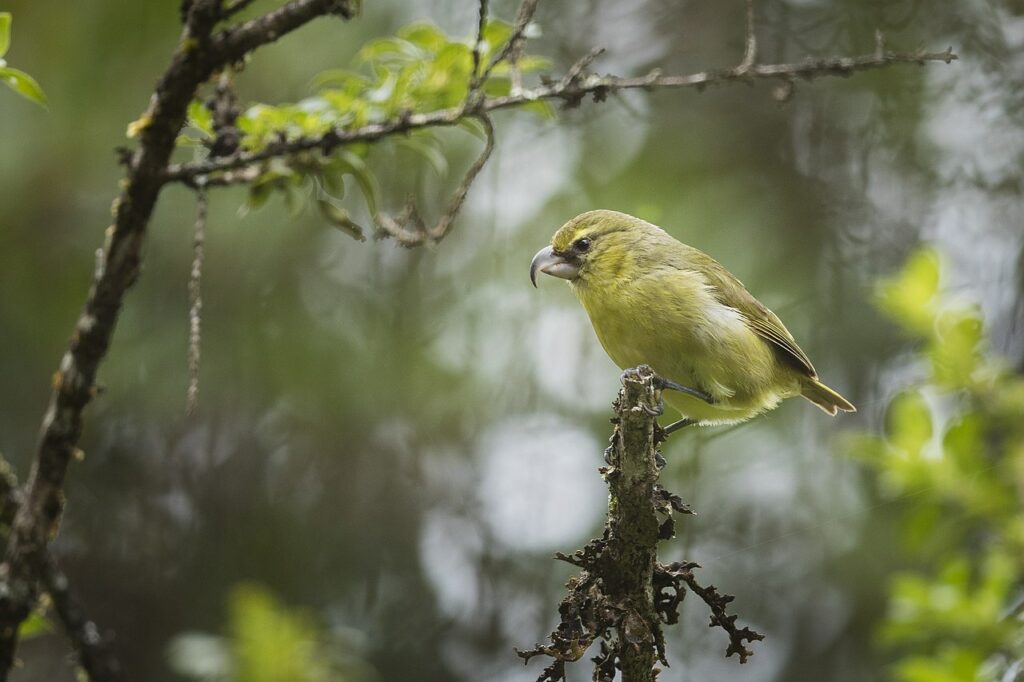
“From the lofty summit of Hāna Mountain/ The high, dark forest flank is visible/ However, it is obscured by the strata of clouds/ The upper windward flank of countless birds is hidden/ The echo of many bird voices, comes up from below/ And the Ko‘olau district is brimming with birds/ But harken now to this that strikes the ear/ The clear call is carried by the kiu mountain wind/ The call of the understory shrubs it is heard,/ By the birds of the wet forest so/ By the ‘I‘iwi that is dampened by the rain/ By the ʻĀkohekohe grumbling in the forest/ By the yellow Nukupu’u with its curved bill/ Oh Kiwikiu/ Oh Kiwikiu/ You’re such and outstanding bird and blessed with beauty/ Oh Kiwikiu/ Oh Kiwikiu/ Your stout curved bill is always snapping/ Approach and occupy your perch/Here is a thriving bird/And may you thrive indeed”
-Sam Ohu Gon III (11)
Native Hawaiian Mythology:
According to one Hawaiian myth, all of the birds of Hawaii were once invisible, such that the people could hear their songs and see movement in the trees, but could not perceive the birds themselves. The only man who could see the birds was the god, Maui. One day, Maui decided to paint the birds in bright colors for his own enjoyment. To ‘I’iwi, Maui gave bright red feathers. Now, the other people still could not see the birds, but Maui loved to watch them fly. One day, Maui was visiting with a god from another island who was boasting about the beauty of his home. Annoyed by his boasting, Maui decided to lift the veil which prevented others from seeing his birds. All at once, the islands came alive with color and all who looked upon “I’iwi and the others knew that Maui’s home was the most beautiful of all. (12)
According to a well-known Hawaiian love story, the Paliuli chiefess La‘ieikawai’ is said to live in a house thatched with the vibrant feathers of Honeycreepers. One Honeycreeper in particular, ‘Apapane, is said to be her special servant. According to legend, when a Kauai chief courted her, La’ieikawai’ instructed him on when he could meet her based upon the sounds of the birds of the forest. When a certain bird would sing, she would be getting ready to meet him, when another would sing, she would leave her home to search for him. According to legend, it was the song of ‘Apapane which told the chief to go and find her so that they could be together at last. (13)
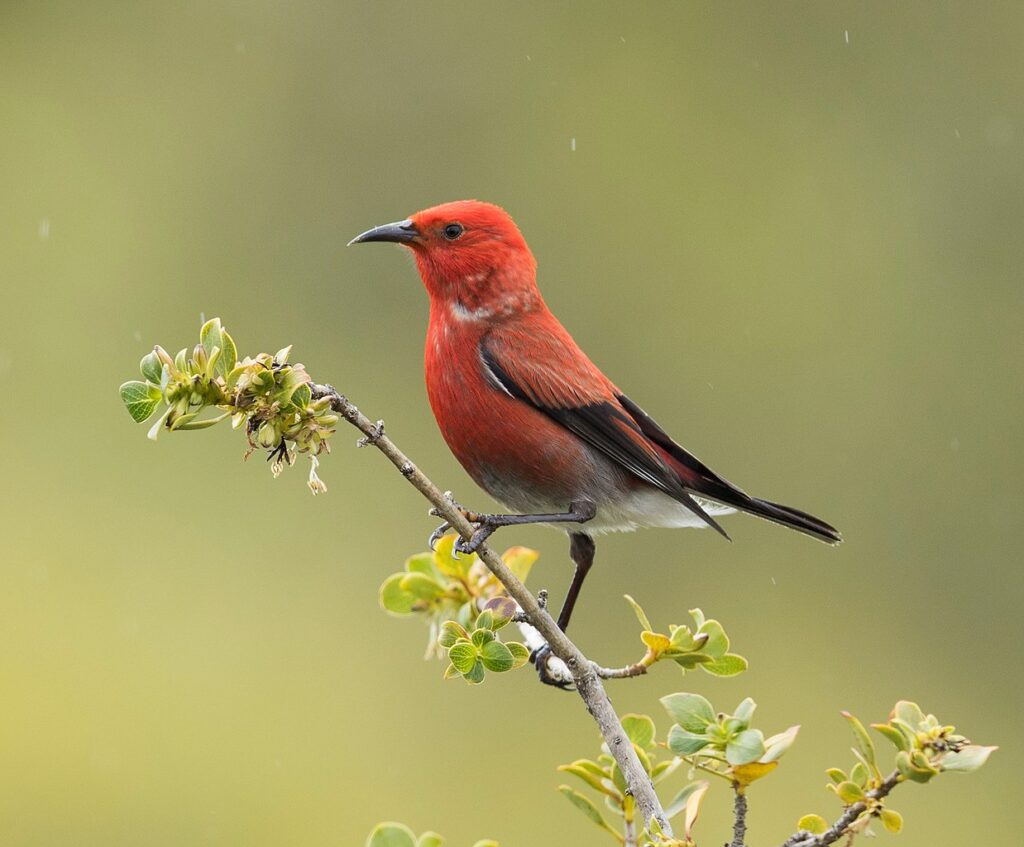
Honeycreeper Spirit Animal
If your spirit animal is the Honeycreeper then you are an innovator. People with the Honeycreeper as their spirit animal do not look for excuses or escapes, they seek out solutions. The Honeycreeper spirit animal rises to the challenges of everyday life by improving itself in new and unexpected ways. People with the Honeycreeper as their spirit animal tend to be creative thinkers. On a team, they are likely to be the ones dreaming up big ideas. This is one of the Honeycreeper spirit animal’s strengths, however, this can result in a bit of tunnel vision. The head-in-the-clouds Honeycreeper thrives when it finds friends and collaborators who balance its energy with down-to-earth pragmatism.
Honeycreeper Totem Animal
The Honeycreeper totem animal is connected with seasons and change. Like many Honeycreepers which live their lives as “altitudinal migrants,” the Honeycreeper totem animal moves through the seasons of life with grace and ease. Always chasing the flowers that bloom, the Honeycreeper totem is an expert at embracing new chapters and finding new opportunities to make memories, achieve great things, and improve itself. People with the Honeycreeper as their totem animal are optimistic, expressive, and often wise beyond their years.
Honeycreeper Power Animal
The Honeycreeper power animal is connected with romance and family. Like the story of La‘ieikawai’ and ‘Apapane, the Honeycreeper is often connected to ideas like vitality, femininity, and sensuality. The Honeycreeper power animal provides healing and protective energies for relationships and families.
Honeycreeper Tattoo Meaning
A Honeycreeper tattoo may represent conservation of a desire to protect Hawaii’s threatened native wildlife. For a person of Hawaiian descent, a Honeycreeper tattoo may bear special cultural significance which might tie into particular myths, like Maui and ‘I’iwi, or cultural practices. Such a tattoo may represent a spiritual connection with the Hawaiian islands and their rainforest habitats.
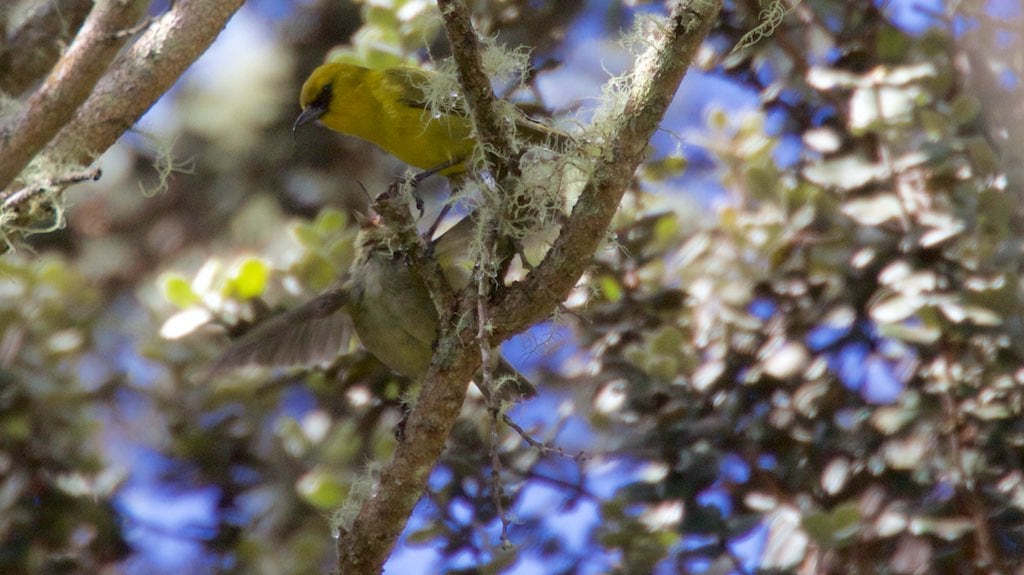
A Honeycreeper tattoo may also represent adaptability, versatility, or vibrancy.
Conclusion
After learning a bit more about the unique, stunning, and fascinating Honeycreepers, it feels even more heart-breaking to face the reality that many of these birds are facing the very real possibility of extinction within the near future. Most of us who do not live in Hawaii have never heard of these birds and I think that that is a shame. If we are to preserve Kiwikiu, ‘Apapane, ʻAkiapolaʻau, or any of the other threatened Honeycreepers, it is critically important that we remain aware of their plight. Hopefully, this article has raised your interest in these exceptional birds.

